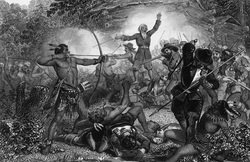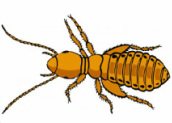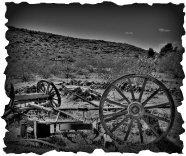Hardships
There were many hardships and challenges along the way on the Orgon Trail. Some hardships of the journey were death of relatives due to accidents, indian attacks, supply shortages, weather, drowning, disease, terrain, and even medicine. A challenge faced by most travelers was to steady their usage of money along the Oregon Trail. These hardships were fatal, but not as much as the problem of reaching and passing the mountains before winter begins. Some of these problems were not as harsh as others, but each posed a dangerous threat to them finishing their journey.
Mourning
A death of a family member or a loved one could be one of the hardest things to overcome along the trail. Some people could never get over the death. Sometimes only a single person from a whole family would make it to Oregon. As a loved one would die, so would the travelers desire to keep going.
Accidents
Accidents are very common along the Oregon Trail. One of the most common accidents, but not the most lethal was falling and getting run over by a wagon or two. Another accident that did not occur as much as being ran over, but even more deadly, was accidental gunfire. During celebrations a person would get so happy and accidentaly shoot someone causing livestock to stampede which also killed people. These accidents were always made at some point in every wagon train on every travelers journey.
Native American Confrontations

While most encounters with Native Americans were friendly, sometimes, they even saved travelers. However, there was always the threat of an attack. In 1862, Native Americans attacked emigrants near Massacare Rock. In January of 1863 Col. Patrick Conner felt the need to punish the native tribes along the trail. Out of all the confrontations with Native Americans, the one that seemed the most significant occured at Fort Laramie in 1854. The Natives primarily only attacked emigrants when they would settle on their land. Although the natives were usually nice and helpful, but could still be a great threat.
The best known incident between Hudson Bay Company and the natives which happened near Massacre Rock. This conflict was called the Massacre Rock Incident. The natives had seemed to be using "guerilla tactics." By appearing suddenly to attack while suddenly disappearing the next second which resulted in the death of 5 emigrants. The next day, the remaining amount of emigrants persued them for seven miles. This final attack led to the death of at least 4 more emigrants.Even thouogh this native encounter was well known, the death toll was slim to none.
As tensions between the natives and the U.S. grew, more and more people felt like they should punish the Natvie Americans. In January of 1863 Col. Patrick Conner, a man wanting to punish the natives, was stationed near Salt Lake City. He and his California volunteers traveled to Bear River. At that river they attacked and killed 400 Shoshone men, women, and children. This confrontation was where the most natives were killed in western history. But this wasn't the end of bad blood between the natives and the Americans.
In 1854, a very important confrontation with natives occured near Fort Laramie. Surprisingly, this occured three years after the Fort Laramie Treaty. This incident was called the Grattan Massacre, named after Lt. Grattan who ordered to open fire. This blood shed all started because of a single cow. As the cow wandered away from a wagon train, a Sioux tribe saw this cow and ate it. As Grattan and his 28 men left Fort Laramie to punish the Sioux, the tribe offered a horse in appology. Grattan did not want the horse so he opened fire on the Sioux. The Chief ordered not to counterattack. Then, Grattan fired again and killed the Chief. This erupted into the Native American Wars of the 1860's.
Altough Native Americans were usually nice along the Oregon Trail, there were many occasional attacks on both travelers and Natives. An incident where natives attacked emigrants was at Massacre Rock. A brutal attack against the indians occured at Bear River killing an outstanding amount of indians. One of the most significant battle with the Natives was located around Fort Laramie. Indians might've been nice, but the outcome of the brutal battles had changed all of that.
The best known incident between Hudson Bay Company and the natives which happened near Massacre Rock. This conflict was called the Massacre Rock Incident. The natives had seemed to be using "guerilla tactics." By appearing suddenly to attack while suddenly disappearing the next second which resulted in the death of 5 emigrants. The next day, the remaining amount of emigrants persued them for seven miles. This final attack led to the death of at least 4 more emigrants.Even thouogh this native encounter was well known, the death toll was slim to none.
As tensions between the natives and the U.S. grew, more and more people felt like they should punish the Natvie Americans. In January of 1863 Col. Patrick Conner, a man wanting to punish the natives, was stationed near Salt Lake City. He and his California volunteers traveled to Bear River. At that river they attacked and killed 400 Shoshone men, women, and children. This confrontation was where the most natives were killed in western history. But this wasn't the end of bad blood between the natives and the Americans.
In 1854, a very important confrontation with natives occured near Fort Laramie. Surprisingly, this occured three years after the Fort Laramie Treaty. This incident was called the Grattan Massacre, named after Lt. Grattan who ordered to open fire. This blood shed all started because of a single cow. As the cow wandered away from a wagon train, a Sioux tribe saw this cow and ate it. As Grattan and his 28 men left Fort Laramie to punish the Sioux, the tribe offered a horse in appology. Grattan did not want the horse so he opened fire on the Sioux. The Chief ordered not to counterattack. Then, Grattan fired again and killed the Chief. This erupted into the Native American Wars of the 1860's.
Altough Native Americans were usually nice along the Oregon Trail, there were many occasional attacks on both travelers and Natives. An incident where natives attacked emigrants was at Massacre Rock. A brutal attack against the indians occured at Bear River killing an outstanding amount of indians. One of the most significant battle with the Natives was located around Fort Laramie. Indians might've been nice, but the outcome of the brutal battles had changed all of that.
Chart of Emigrants Killed by Indians
Year1840-1844
1845 1846 1847 1848 1849 1850 1851 1852 1853 1854 1855 1856 1857 1858 1859 TOTAL | Number of Deaths0
4 4 24 2 33 48 60 45 7 35 6 20 17 Unkown 32 337 |
From The Oregon Trail Yesterday and Today by William E. Hill
Supply Shortages
When travelers would underestimate the amount of supplies to bring, it could result in a supply shortage. Once this happens, the trip becomes miserable by trying to ration food evenly until they get to the next fort. For example, the Whitman party ended up having to live off of dried buffalo meat. The supply shortages do not always have to be food shortages, they could also run out of spair wagon parts and even clothing. If a wagon breaks down without having any spair parts to fix it, the travelers would surely die. Supply shortages can result into an inevitable death
Weather

Weather was a large factor in trying to make it across the Oregon Trail. Most of the bad weather would occur along the Rocky Mountains. Here there would be large snow storms, this gave a large threat of frostbite and freezing to death. In other locations along the trail, large downpours would sweep emigrants away like flood streams and make the roads muddy. The more miserable results of the weather was when fine powdery dust from Sublette's Valley would get into the travelers eyes. This would cause their eyes burn and make them cough. Weather is a threat that was impossible to avoid along the entire trail.
Drowning
Drowing was alawys a constant factor while trying to cross rivers. One of the more treacherous rivers was the Green River, which alone had killed 37 people in a single summer. To escape this danger, many people took a ferry. Some ferries would cost about $16 to ship across their supplies which was not always totally reliable because the owners might've gotten greedy and overstocked the ferry with supplies. There was no way to be 100% sure that travelers would make it across rivers without drowning.
Diseases

Along the Oregon Trail, diseases varied from quick and painless to slow and miserable. Out of all the diseases, two of the more painful ones were malaria and scurvy. The weirdest disease that had the potential to be deadly was head and body lice. The disease that killed the most people was cholera. Diseases seemed to be one of the leading causes of death along the Oregon Trail.
Two very aggresive diseases were malaria and scurvy. Malaria is transfered to the body by a mosquito that is already carrying the disease. This disease caused chills, sweats, fevers, and abdominal pain. Malaria would occupy and destroy all red blood cells. Scurvy is a disease cause by lack of nutrition in their diet. This caused swelling and bleeding of the gums. Internal haemorrhages are another side effect caused by scurvy. Among some of the painful diseases, malaria and scurvy seemed to be the worst.
One of the diseases that was really common but one would least expect to be deadly is head and body lice. This disease was really common because of the lack of clean bathing water. Once someone catches lice, the six legged insect would infest their hair and start to feed on their blood to lay eggs. This would cause the infestation to keep growing. When this happens irritation of the skin will occur. Once travelers would start scratching the itch they might have made cuts which could get infected. Head and body lice is a disease which allowed other diseases to easily access a pioneer's body.
Of all the diseases, the most deadly and common was cholera, which began to take a massive toll during the years of 1849-1852. The disease had killed people almost instantaneously. Travelers can be fine one day, but the next they would wind up dead. On some bad years about two-thirds of a single wagon train can lie dead on one journey. Sadly, some of the sick did not even get a proper memorial and worse some were abandoned and left behind to die. Some of the dead who had been buried had ended up being dug up by wild animals on the trail. Sad but true, cholera was the main reason most travelers were not able to reach their destination.
Diseases seem to vary greatly along the Oregon Trail. Two of the most dreadful diseases on the trail were scurvy and malaria. The least expected of all the diseases along the Oregon Trail was head and body lice. Cholera, being one of the most lethal, was one of the most common. Throughout all of the dangers of the journey, disease killed off most of the travelers.
Two very aggresive diseases were malaria and scurvy. Malaria is transfered to the body by a mosquito that is already carrying the disease. This disease caused chills, sweats, fevers, and abdominal pain. Malaria would occupy and destroy all red blood cells. Scurvy is a disease cause by lack of nutrition in their diet. This caused swelling and bleeding of the gums. Internal haemorrhages are another side effect caused by scurvy. Among some of the painful diseases, malaria and scurvy seemed to be the worst.
One of the diseases that was really common but one would least expect to be deadly is head and body lice. This disease was really common because of the lack of clean bathing water. Once someone catches lice, the six legged insect would infest their hair and start to feed on their blood to lay eggs. This would cause the infestation to keep growing. When this happens irritation of the skin will occur. Once travelers would start scratching the itch they might have made cuts which could get infected. Head and body lice is a disease which allowed other diseases to easily access a pioneer's body.
Of all the diseases, the most deadly and common was cholera, which began to take a massive toll during the years of 1849-1852. The disease had killed people almost instantaneously. Travelers can be fine one day, but the next they would wind up dead. On some bad years about two-thirds of a single wagon train can lie dead on one journey. Sadly, some of the sick did not even get a proper memorial and worse some were abandoned and left behind to die. Some of the dead who had been buried had ended up being dug up by wild animals on the trail. Sad but true, cholera was the main reason most travelers were not able to reach their destination.
Diseases seem to vary greatly along the Oregon Trail. Two of the most dreadful diseases on the trail were scurvy and malaria. The least expected of all the diseases along the Oregon Trail was head and body lice. Cholera, being one of the most lethal, was one of the most common. Throughout all of the dangers of the journey, disease killed off most of the travelers.
Terrain

The terrain along the Oregon Trail was very treacherous. Rivers were a large cause of death due to drowning. Around 1,200 miles, in approximately three and a half months after the start of the trip, the Rocky Mountains began. Although the Rockies were tough to pass, the real challenge was the Blue Mountains. The men and boys would have to pull the heavy wagon up the mountain side with ropes and pulleys, while the women and children would lay rocks down behind the wagon so it would not roll backwards. On the other side, it would be just as hard to get the wagon to go downhill at a slower speed. This takes muscle, prayer, and a bit of luck. The trails rough terrain was a large obsticle to overcome.
Medicine
Medicine, even though it was meant to save travelers, killed a few. This event seldom happened. Once in a while the women would make medicine and leave it out. A child might see it just laying there so, they might figure it is juice and drink it. Later the child will become sick, and after a while the kid would eventually die.
Mountain Ranges
Time was an important factor in the trip considering that if you were caught in or getting to the mountains when winter came you would die. When travelers are in the mountains and winter begins, they are going to experience a numerous amount of troubles. First, the travelers would get trapped in the snow. Afterwards, the animals would start to die off. Due to the freezing weather, the travelers would develop frostbite beginning in the fingers and the toes. At some point later the travelers would slowly freeze to death. This is exactly why most travelers had rushed and hurried across the mountains.
